Electronic Regulators
The Bella holds a mechanical regulator from factory. It truly is a little mechanical wonder created by the firm Bosch. It holds an electromagnet in the form of a small coil that allows the regulator to charge from a certain voltage to prevent the battery from emptying out as the regulator is connected to ground. This coil is calibrated to close the charging contact just above the maximum charge of the battery at rest. Another set of points can be calibrated to set a minimum voltage when the regulator will send through current to the matter and a maximum at which point the charging stops.
These units should last at least 60.000 miles, but over time the two sets of contact points can wear out or the metal springs used to calibrate the electromagnet can get metal fatigue or vibrate loose. When this happens, you will usually find that the red charging light may come on at lower revs or if the charging window becomes too small, the battery is not charged enough. At this point you may find the battery gets drained when riding with lights on or even that the battery gets charged insufficiently for just the ignition. Keep in mind that the ignition is battery fed, so if the battery charge drops below a certain point, gone is your spark.
In many cases, the regulator can be re-calibrated if in good condition. This requires some knowledge however, a variable DC power supply 0-20V and a test rig consisting of a load (a 6 or12V 60 Watt halogen bulb), wires, and some 6 or 12V test bulbs. This of course whether you ride kickstart model (6V) or an electric start (12V).
We do however find, that many regulators have lost the rubber seal on the housing, which means the internals (including the points) can be badly corroded. At that point, a replacement regulator is required, or, as an alternative, one can switch to an electronic regulator.
Electronic regulators have a few advantages: they provide more efficient charge (more power at lower revs), they provide the right charge (unless they fail) and don’t require recalibrating.
So, let’s take a look at which regulators can be replaced. There are, in fact, four types of regulators provided with the Bella from factory:
- The F-type regulator (named so because you can recognise an F shape in it) built into the kickstarter models. This is the open regulator with its innards showing under the ignition cover and is fully hidden from view. The disadvantage of this model is that it’s close to the engine and will usually affect the insulation of the electromagnet wiring over time. However, again, they should last 60k miles. The design is very robust.
- The large casing external regulator with two screws on top. Inside is that same F-type regulator. This regulator is fitted between the battery boxes of the electric start models. The mounting plate has a 90-degree angle and is screwed to the side of the left battery box. This unit is easiest to work on as it’s large, but it’s also quite heavy and usually leads to metal fatigue through vibration of the side of the left battery box. Frequently, tears in the sheet metal are visibly there.
- The small casing external regulator where the top isn’t screwed on, but where two small opening are clipped around two small protrusions on the ground plate. These are the later model regulators. They do not have the same calibration options (they are simpler), but with some effort they can still be repaired. They also weigh less and therefore don’t cause tears in the battery box sheet metal as easily. These regulators are also placed between the battery boxes.
- The very latest Bellas (Bella 200, Bella 175 and some late R204 models allegedly) had a regulator that included a starter relay (to unburden the ignition locks). These regulators are chunkier, square boxes and were mounted under the front support of the rear hub between the two frame rods.
All of these Bella’s can be fitted with an electronic regulator:
– The kickstarter models can be fitted with an electronic regulator that fits nicely where the old one set. It is pretty much a swap out. This only requires a little re-wiring for the regulator.
– Both the small and large regulators housings can be fit with a replacement electronic regulator that fits in the original housing. This is a really sympathetic replacement, as you will not be able to see the difference between the old regulator and the new electronic one. Fitting a regulator in the housing is a bit of a fiddly job. Some suppliers do this for your however. Should you do this yourself the main thing to look out for is to ensure the contacts on the ground plate of the old regulator do not cause a short with the new regulator or its wiring. This can be done using plastic spacers and or screws and nuts where appropriate. It should be noted that the replacement is easier for the large form factor old housing as electronic regulators can be bought that fit right onto the ground place with screw holes that are identical to the fixing screws of the old regulator.
– Finally, the last form factor regulator for the latest models does not offer an easy in-housing replacement. This may be possible but I have no information on this.
The good news is that for any Zundapp Bella you can also use the much cheaper MZ regulator. However, this regulator, while fine for a Bella, will not fit in the old housing and installing this regulator will be less pleasing to the eye due to having to fit it somewhere. For the kickstarter models it will also require new wiring external to the engine.
Just make you order the right voltage electronic regulator; 6V for the kickstarter, 12V for the electric start.
So, it all good news? Well, mostly. The only downside of the electronic regulators is that they will not survive incorrect wiring, so triple check you’ve done your wiring correctly hooking them up as they are not cheap. Expect to spend 100 to 200 EUR on a form fitting model. I’ll repeat the warning about incorrect wiring; even a short time in use with incorrect wiring will destroy the regulator.
LifePO4 batteries
Those who use the classic lead-acid batteries will know that for the electric start models they are just about powerful enough when new to properly crank the engine. As they age, you better hope the engine starts up quickly, otherwise it’s pushing time.
However, modern batteries offer great alternatives. LiFePO4 batteries are much lighter, much smaller and much more powerful than the lead-acid ones. A single battery of that type, can replace two lead acid ones. However, this type of battery must NEVER be overcharged by too high a voltage and this is easily possible with an old-style regulator. Should you wish to switch to LiFePO4 batteries, then an electronic regulator is a requirement.
Unless you want an all-original Bella, a battery upgrade is something you will not regret. And if you wonder whether such a small battery that almost feels like a toy when you get it due to its light weight can do the job: yes, it can, and better than the original.
The regulating resistor
This part is extremely important. Forget this and your shiny new electronic regulator will at best not work and probably be damaged, so pay attention.
Your Bella has a regulating resistor for built into the generator. This is a requirement when using a mechanical regulator, but MUST BE REMOVED when fitting an electronic regulator.
For 12V models it is a physical small coil in the ignition. Simply cut and insulate the wire leading to that small coil, the coil can stay in place. Simple job and you should do this in a way that it is reversible. This resistor can be found here:
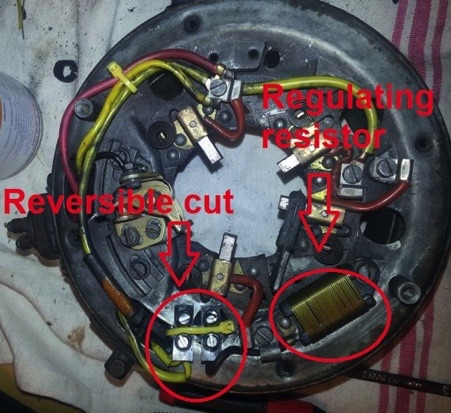
For kickstarter models this is a bit more difficult and there are two variants, so please pay attention. We’ll start with a little bit of theory so you know what to look for. The field coils, these are the wound coils on the inside of the generator are connected on one end to the plus brushes in the ignition and on the other end connected to ‘F’ on the regulator. These coils are also connected to ground at the end of the coils just before the regulator through this regulating resistor. For the 6V models, this resistor is part of the wire itself (it’s a special bit of wire), so it’s not easily identified.
Here’s a picture of the F connector:
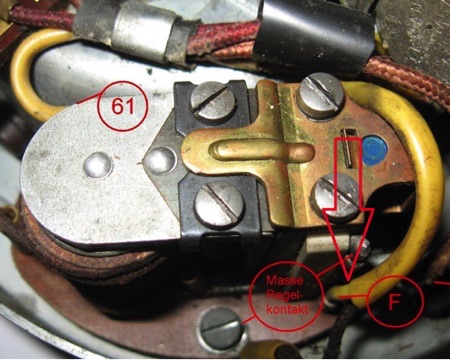
There are two variants of how this resistor wire is connected.
In variant one, you will find that there are two wires at the F connector that both go into the yellow sheath. One will go to the resistor and from there to ground; the other will go to the field coils. You can trace where these wires go with a bit of effort. Once you know, disconnect the wire to the resistor (e.g. by cutting it, covering it with shrink-tube and using a tie rip to hold it in place).
In variant two the resistor wire is soldered onto the wire from the field coils directly, rather than connected to F on the regulator. In this situation, you’ll usually find two yellow wires going into one sheath just before the regulator. Again, one of the two, leading through the resistor need to be disconnected.
Luckily we can bypass most of these issues if your ignition is original. You can disconnect the resistor here:

(thanks to Matthias Henze for the picture). You can use the same spot on most of the 12V Dynastart versions too.
So where can I get one of these electronic regulators?
The electronic regulators are sold by various shops. Here are some examples but the list is not exhaustive. You will also find that some suppliers have long waiting lists. In many cases these are small outfits / hobbyists and many of these regulators are made to order; so please be polite, kind and patient when ordering. Also, don’t expect a guarantee. 99% of the problems are from incorrect installation rather than a faulty product. Also, don’t expect that you can call for help installing them. A one-page installation manual is usually provided, but you are expected to know what you’re doing. Troubleshooting can easily take a few hours and these shops need to produce, not spend time on the phone. You will find your supplier very short on the phone and very reluctant to talk to you for a reason. Be happy these products are produced at all, and call a knowledgeable friend if you’re not confident.
Electronic Data Kleiber
Electronic Data Kleiber from Germany (http://edknet.de/) has a service where you can send them the housing of the old regulator and they will build the electronic regulator into it. The result looks like this:
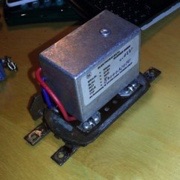
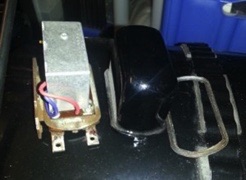
Please note that this is the small type of housing. The regulator is insulated from the base place using plastic spacers where appropriate. It’s a bit of tight fit, but it does work. This is a high-quality product, made by an enthousiast, so expect a long lead time and don’t expect any help. This outfit also sells regulators for kickstarter models that have the same form factor as the original.
Team Pawelczak
The second option is to order an electronic regulator from Zofia Pawelczak (Z.Pawelczak@web.de). She does the sales and her husband makes the units.
They sell electronic regulators for both the kickstarter and electric start models. Both types are a form factor that is a swap out for the original. They also sell electronic ignition should you be interested (note: this replaces your contact points and condenser, not your ignition coil or generator).
You’ll have to build this into the housing yourself using some plastic bushes under the regulator to prevent a short-circuit!
Once built-in you can simply place back the regulator and you’re all done. Please note: there usually is a waiting list for these regulators, so a timely order is a good idea.
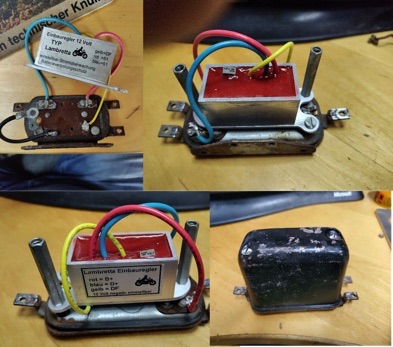
The 6V model looks like this and fits kickstarter Bellas but also 200S / 201S / 250S / some DB models:
Andreas Osterhaus
The firm Osterhaus fully restores ignitions (including field coils, ignition coil etc). They have a website here: https://www.andreas-osterhaus.de/
They also have a webshop but it is rather profunctory at this time; they sell much more than what is visible on their website, so write or call them if you wish to have your ignition restored or just need a regulator.
Motorrad Meister Milz
Motorrad Meister Milz is a firm that offer many parts for oldtimer motorcycles, including some Zündapps parts. They sell this VAPE (=PowerDynamo) external regulator:
https://www.motorradmeistermilz.de/VAPE-Elektronischer-Spannungsregler-Laderegler-R81-6V-Elektronik
This one is for kickstarter only and has to be fit externally to the engine as it won’t fit in the ignition compartment. On the plus side, it’s cheap and quite reliable. It looks like this:
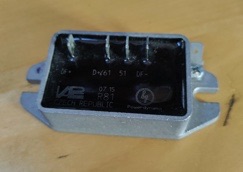
You can buy it at source as well: https://www.vape.eu/en/regulator-r81
Zuendappshop.de
This shop sells an electronic regulator for the 12V Bella. This one looks the same as the model from EDK, and given the brand is covered, I suspect this is reselling that same regulator as they also offer to install the regulator in the old housing.
https://www.zuendappshop.de/en/regler-12v-fuer-zuendapp-bella-zum-einbau-in-alten-regler.html
On the same site you can also buy regulators that appear to come from Team Pawelczak:
https://www.zuendappshop.de/de/-5895.html
So this might be a case of paying a bit more for a quicker delivery time.
Beware of cheap reproduction
Note that you can also find the external model from VAPE on aliexpress. For example here: https://nl.aliexpress.com/item/4000720962795.html?src=google&aff_fcid=ebd0fdde7c7f483cb8e70f5701621860-1705934858191-02032-UneMJZVf&aff_fsk=UneMJZVf&aff_platform=aaf&sk=UneMJZVf&aff_trace_key=ebd0fdde7c7f483cb8e70f5701621860-1705934858191-02032-UneMJZVf&terminal_id=0c10efabf90b4764ba12abf7e1b03af9&afSmartRedirect=y&gatewayAdapt=glo2nld
But please note that these are reproductions and you never know what’s inside the resin; it’s unlikely to be the same quality as the original…
Also, please note that the Bella generator delivers direct current, NOT alternating current, so modern cheap regulators will NOT work, had you thought about trying 😊.
Article by Bert Zwiers, ZBEC





